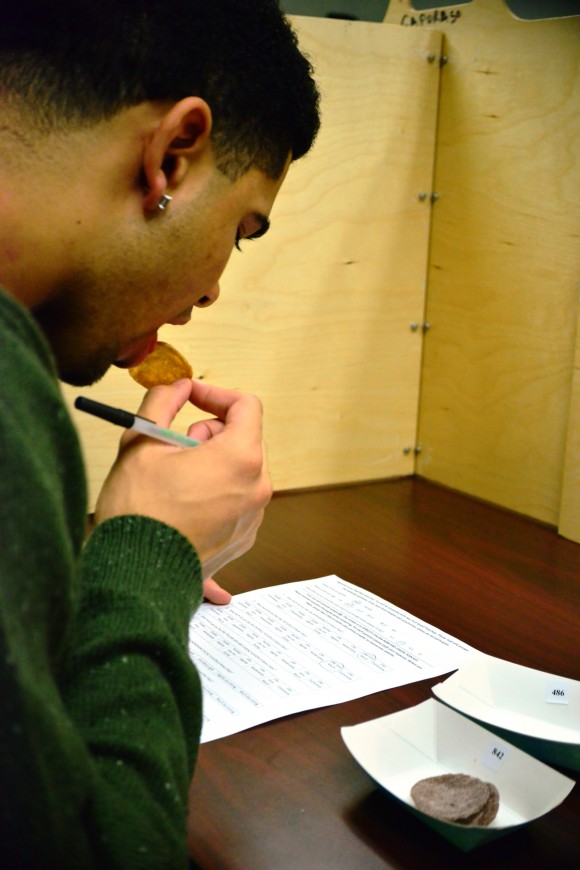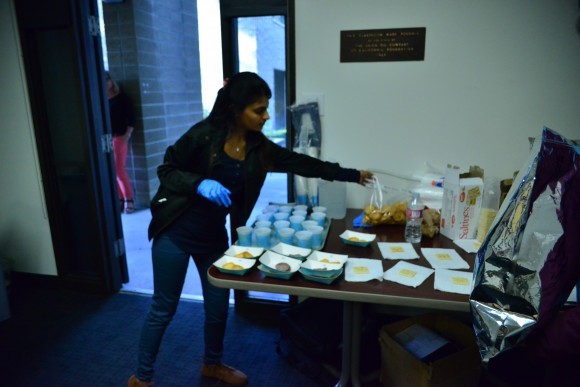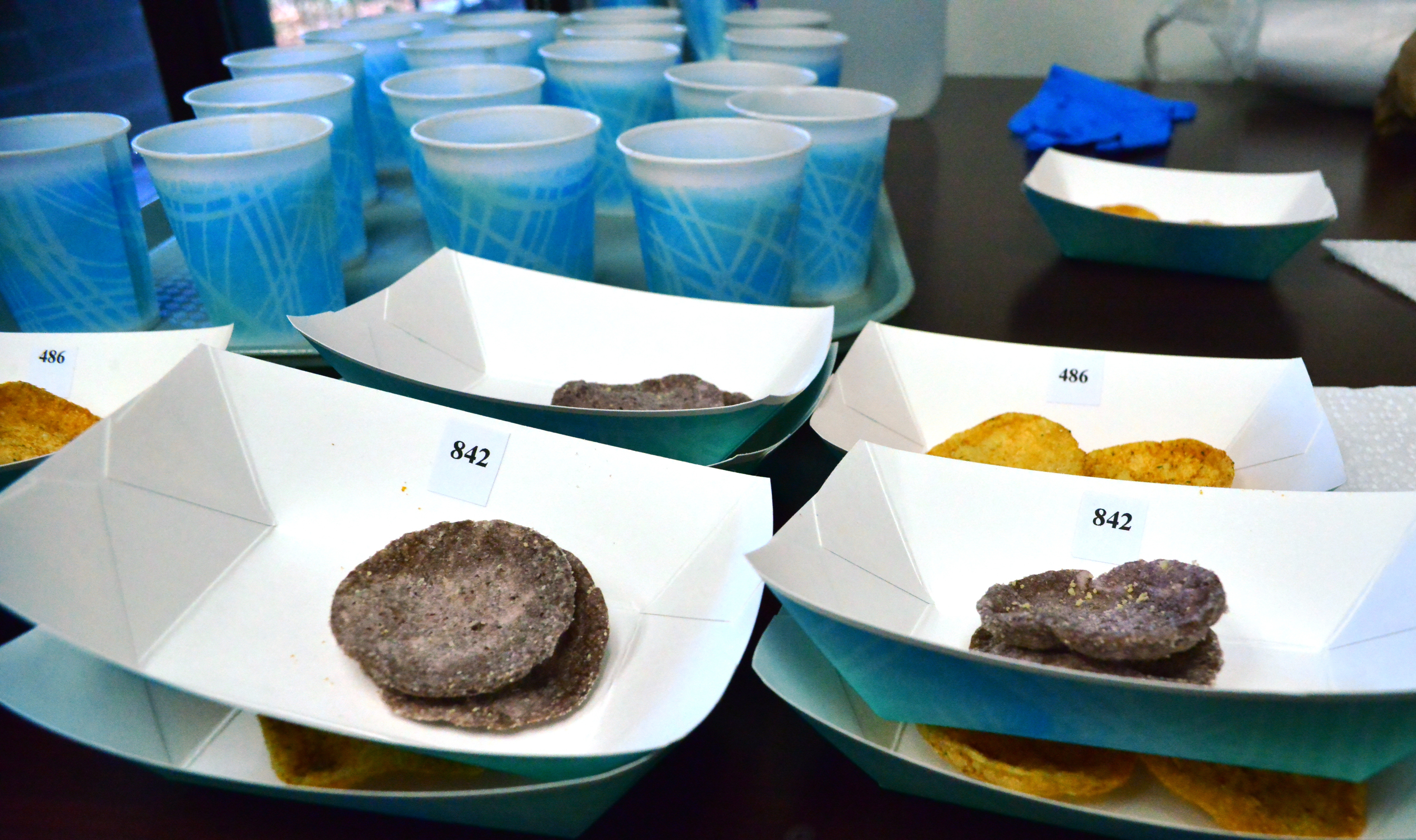
Mason Shepherd ’19 devours an Apricot Italian Herb chip.
“Oh, oops. I messed up … I just couldn’t resist eating them,” Mason Shepherd ’19 says with a laugh. Shepherd had skipped the palate cleansing saltine and cup of water he was supposed to imbibe before venturing down the path of new chip flavor taste testing. The samples were just a little too tempting. Not a bad problem for a chip to have.
In a corner classroom of Chapman University’s Hashinger Science Center, students and faculty dutifully crunch through tiny portions of innocent looking chips. Don’t let your eyes deceive you though – the little crisps are hiding unexpected flavors.
The innocuously named sample numbers 486 and 842 are silver-dollar-sized snacks on the
PopChips
format are boldly pushing flavor profiles in an answer to consumer interest in unique flavor combinations.
Today’s chips are branching out into savory fruit flavors that might work better as mid-morning snacks: Apricot Italian Herb and Cheese and Blueberry Greek Yogurt, respectively.
Food science students in the Food Product Development course are hard at work developing and testing their hand at creating new flavor profiles, the results of which are presented to the PopChips CEO and research and development at the end of the semester–real world practice with a potential market payoff.
While taste is the top priority, chip developers also have to address another food aspect: Does the chip
feel
good?
Tirtha Thakkar (’18 M.S., food science) explains that the idea for a unique chip flavor is more than just the way it tastes. Snack eaters may end up judging a chip by its cover. So, there’s a test for that and other non-flavor factors of food.
“What we’re doing is sensory testing: the taste, texture, the appearance and the odor of the food,” Thakkar said.
The questionnaire being handed out with the snacks runs the chip eater through a gamut of questions about the texture, smell, appearance and overall flavor profile of the chip. Answers are ranked from “Dislike Extremely” to “Like Extremely.”
But first and foremost – does it taste good?
Shepherd seems to think so.
Pond hopping, chip popping
Flavored chips are enjoying a spike in popularity that has big and little name companies lacing snacks with tastes far beyond the realm of BBQ, ranch or spicy — the standard flavors.
Depending on where you are in the world you can have biscuits and gravy flavored chips, pickle flavored chips, chicken dinner and, gasp, haggis flavored chips. Yes — such a thing exists in Great Britain, where they’re called crisps. The funny-flavored crisps trend has been en pointe for years.
But back on this side of the Atlantic, the market is a moving target, which is one part sweet (the creativity) and one part savory (the audience) in terms of development. A flavor demand may crop up in one region that will have no play in another.
If you want an example of flavor that can be fickle, think pickle.
Brent Cross (’09 M.S., food science) is manager of regulatory and quality systems for PopChips and said even between such close neighbors as Canada and the United States, flavor trends can be starkly different.
“The flavor profile deep end — we had a dill pickle flavored chip which was very popular in Canada,” Cross said.
Pickle has occasionally graced the U.S. snack stage: Frito Lay company has recently had a limited run Dill Pickle chip.
Food science student Emma Gottschall (M.S. ’16) was involved in some product testing for a pickle popcorn. By whom? Gottschall’s not saying — but what she will say is it wasn’t bad.
What seems to do well in other countries, according to Cross’s notes on popular flavors, are the more savory tastes. Pickle does well, but there’s one that does better in Canada.
“What’s really popular there is ketchup,” he says.
Yes, ketchup flavored chips are the big taste deal up north, while we at home are swaying closer to sweet with the newest U.S. Popchip: Sweet Potato Cinnamon Twist. Another flavor that did well on the West Coast recently was Kettle Corn.
Get them while and if you can — the former is just now on the market and the latter was a limited run.
Strength in small numbers
If a chip flavor is a response to consumer demand, why limit it? And why is the market for odd flavors picked up by chips in the first place?

Tirtha Thakkar ’18 preps trays of chips for sensory testing.
It boils (or in this case pops) down to risk mitigation. While a flavor might find a foothold interest, it may not have long-term or season-to-season staying power.
Gottschall, who has tasted orange chicken flavored snacks, explained that while a flavor may be good, another mitigating factor is how the public can understand the food as a concept — can they wrap their heads and their taste buds around it?
However, this kind of curiosity in the taste frontier is particularly suited to the chip and snacks industry.
Gottschall explains, post PopChip taste test, a chip is a low-cost, easy platform to try an off-beat flavor with.
“You get to try a lot of these unusual flavor profiles in a low risk environment,” Gottschall said. ”It’s a lot easier to create a new flavor for a chip than, let’s say, a frozen dinner.”





Add comment